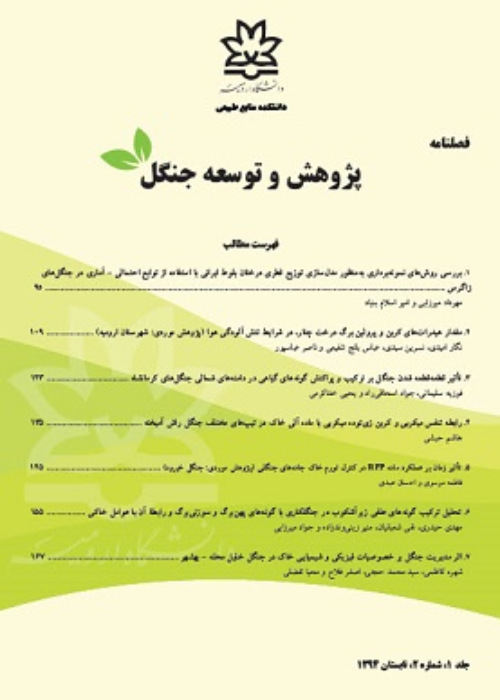Effects of altitudinal gradient on biodiversity indices of plant ecological groups in Hyrcanian forests (Tiremrood basin)
Author(s):
Article Type:
Research/Original Article (دارای رتبه معتبر)
Abstract:
Altitudinal gradient is effective on biodiversity indices. Tiremrud Basin (Watershed 32) were investigated to find the relationship of plant biodiversity indices. Data were collected by transect method with at least one sample plot per align lines with 50 m interval and 44 plots in total. In each sample plot the total number of tree species was recorded. Micro plots (5*2 m2) in four corners and center of each plot were determined and recorded based on the Brown-Blanket cover percentage and frequency of vegetative elements for sampling of herbs. Bilateral index species analysis was used to introduce the communities of the region. The results showed that the four ecological groups of the region had an average altitude of 2070, 1236, 924 and 375 meters above sea level and an average slope of 43, 50, 40 and 59 percent (no significant difference). Comparison of ecological groups showed that these groups have significant differences in terms of plant biodiversity indicators. Examination of Shannon-Wiener and Simpson-Pilo species diversity index values showed that the first, fourth and two second and third ecological groups have maximum, minimum and average values of species diversity indices, respectively. Meanwhile, in terms of Pilo uniformity index, the first and third groups, along with the second and fourth groups, have the maximum, minimum and average uniformity index values, respectively. In terms of species richness index, the first, third, second and fourth groups are ranked respectively. Altitudinal gradient is effective on biodiversity indices. Tiremrud Basin (Watershed 32) were investigated to find the relationship of plant biodiversity indices. Data were collected by transect method with at least one sample plot per align lines with 50 m interval and 44 plots in total. In each sample plot the total number of tree species was recorded. Micro plots (5*2 m2) in four corners and center of each plot were determined and recorded based on the Brown-Blanket cover percentage and frequency of vegetative elements for sampling of herbs. Bilateral index species analysis was used to introduce the communities of the region. The results showed that the four ecological groups of the region had an average altitude of 2070, 1236, 924 and 375 meters above sea level and an average slope of 43, 50, 40 and 59 percent (no significant difference). Comparison of ecological groups showed that these groups have significant differences in terms of plant biodiversity indicators. Examination of Shannon-Wiener and Simpson-Pilo species diversity index values showed that the first, fourth and two second and third ecological groups have maximum, minimum and average values of species diversity indices, respectively. Meanwhile, in terms of Pilo uniformity index, the first and third groups, along with the second and fourth groups, have the maximum, minimum and average uniformity index values, respectively. In terms of species richness index, the first, third, second and fourth groups are ranked respectively.
Keywords:
Language:
Persian
Published:
Journal of Forest Research and Development, Volume:7 Issue: 3, 2022
Pages:
493 to 504
https://magiran.com/p2372869
دانلود و مطالعه متن این مقاله با یکی از روشهای زیر امکان پذیر است:
اشتراک شخصی
با عضویت و پرداخت آنلاین حق اشتراک یکساله به مبلغ 1,390,000ريال میتوانید 70 عنوان مطلب دانلود کنید!
اشتراک سازمانی
به کتابخانه دانشگاه یا محل کار خود پیشنهاد کنید تا اشتراک سازمانی این پایگاه را برای دسترسی نامحدود همه کاربران به متن مطالب تهیه نمایند!
توجه!
- حق عضویت دریافتی صرف حمایت از نشریات عضو و نگهداری، تکمیل و توسعه مگیران میشود.
- پرداخت حق اشتراک و دانلود مقالات اجازه بازنشر آن در سایر رسانههای چاپی و دیجیتال را به کاربر نمیدهد.
In order to view content subscription is required
Personal subscription
Subscribe magiran.com for 70 € euros via PayPal and download 70 articles during a year.
Organization subscription
Please contact us to subscribe your university or library for unlimited access!



